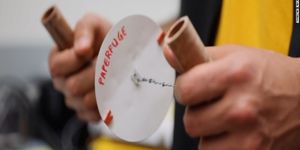'Biobeads' Give Rise to TB Vaccine Showing Success in Mice
Researchers got encouraging results from a tuberculosis vaccine they created with a clever idea. They used natural spheres or biobeads that were assembled by non-pathogenic bacteria, but engineered to display tuberculosis antigens to the immune system. Vaccines are meant to give the immune system a small taste of a pathogen so that it can develop immunity to it. When later exposure might occur, it has a response ready. While there is still a lot of testing that remains for this new idea, if successful this would be the first TB vaccine in over a hundred years and would be a big benefit to communities fighting multi-drug resistant TB. The researchers have published their findings in the journal Applied and Environmental Microbiology. The video below from the CDC discusses the virulence of TB.
The biobeads that are showing promise are made of natural polyester, and these investigators have tested them before but in that case, E. coli bacteria had assembled the biobeads. That testing, done in mice, showed that the biobeads elicited an immune response. "During these experiments the team observed that along with the tuberculosis antigens, E. coli proteins were attached to the surfaces of the crude biobeads," explained principal investigator Axel Heiser, PhD, Senior Scientist, AgResearch Ltd., Palmerston North, New Zealand.
TB is caused by the Mycobacterium tuberculosis or Mycobacterium bovis bacterial strains. The investigators paired it with their successful biobead strategy. "From these observations, we developed the hypothesis that these proteins could also function as antigens," explained Heiser. "If produced in Mycobacteria instead of E. coli, such biobeads should carry mycobacterial antigens on their surface, including many as yet undiscovered antigens which would have the potential to induce protective immunity." Antigens from M. tuberculosis and M. bovis, combined with antigens deliberately placed onto the biobeads by the scientists, would boost the immune response to the vaccine, said Heiser.
Unlike E. coli, however, Mycobacteria don’t have the enzymes required for biobead assembly, explained Heiser. So they researchers looked to alternate cloning strategies that would allow expression of those necessary enzymes in a non-pathogenic mycobacterium, M. smegmatis. The researchers were aiming to eliminate the chance that the vaccine would inadvertently cause a tuberculosis infection.
After the biobeads were made, "We killed and broke up the bacteria, and purified the biobeads," said Heiser. "They are completely natural, and have been shown to be biodegradable."
"We then used these mycobacterial biobeads to vaccinate mice and tested the mice for immune responses," Heiser continued. "We saw evidence of cell-mediated immunity with the potential to be protective against TB. Future studies will include a vaccination followed by challenge with TB to show protection, and also the development of more efficient production and purification methods for the vaccine."
TB remains a serious public health threat not only to developing nations, although that is where it currently does the most damage – 95 percent of TB fatalities occur in low- and middle-income countries. According to the World Health Organization, there were 10.4 million cases of TB and 1.8 million deaths from the disease in 2015. The following video from Steve Kennedy, a doctoral candidate at Albert Einstein College of Medicine, illustrates why a vaccine is important not only to people in poor parts of the world.
Sources: AAAS/Eurekalert! via American Society for Microbiology, WHO, Applied and Environmental Microbiology








